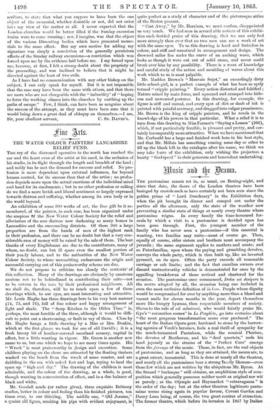fin, arts.
THE WATER COLOUR PAINTERS' LANCASHIRE RELIEF FUND.
THE cry of the distressed operative in the north has reached the ear and the heart even of the artist at his easel, in the seclusion of his studio, in its flight through the length and breadth of the land ; and nobly has he met the demand for succour and relief. No pro- fession is more dependent upon external influences, far beyond human control, for its success than that of the artist ; no profes- sion depends more upon the actual exertions of the individual mind and hand for its emoluments ; but in no other profession or calling do we find a more lavish and liberal sentiment so largely expressed towards distress and suffering, whether among its own body or in the world beyond.
An exhibition of some 300 works of art, the free gift be it re- membered, of the painter, in each case, has been organized under the auspices N the New Water Colour Society for the relief and alleviation of the sore distress now darkening so many homes in Lancashire and the surrounding districts. Of these 300 a large proportion are from the hands of men of the highest rank in their profession, and there can be no doubt but that a very con- siderable sum of money will be raised by the sale of them. The best thanks of every Englishman are due to the contributors, many of whom, no doubt, can but ill spare even the smallest portion of their yearly labour, and to the authorities of the New Water Colour Society, to whose unremitting endeavours the origin and successful carrying out of this praiseworthy scheme are due.
We do not propose to criticize too closely the contents of this collection. Many of the drawings are obviously by amateurs anxious not to be behindhand in contributing their mite—not to be outrun in the race by their professional neighbours. All we shall do, therefore, will be to touch upon a few of those drawings which, to our eyes, are most interesting and attractive. Mr. Louis Haghe has three drawings here in his very best manner (74, 75, and 76), full of fine colour and happy arrangement of light and shade. The "Soup Kitchen in the Olden Time" is, perhaps, the most forcible of the three, although it would be diffi- cult to point out a shortcoming, or fault in my of them. Close by Mr. flaghe hangs a little drawing by a Miss or Mrs. Deakin, which at the first glance we took for one of old David's ; it is a fresh breezy bit of heather-covered moorland scenery, capital in effect, but a little wanting in vigour. Mr. Green is another new name to us, but one which we hope to see many times again. His " Wreck " is most praiseworthy in design and execution. Some children playing on the shore are attracted by the floating timbers washed on the beach from the wreck of some coaster, and are dabbling in the sea with naked feet and legs, trying to haul the spars up "high and dry." The drawing of the children is most admirable, and the colour of the drawing, as a whole, is good, though wanting in concentration of effect, and in a due balance of black and white.
Mr. Goodall sends (or rather gives), three exquisite Brittany studies, better in colour and feeling than his finished pictures, ten times over, to our thinking. The middle one, "Old Jerome," a quaint old figure, smoking his pipe with evident enjoyment, is
quite perfect as a study of character and of the picturesque attire of the Breton peasant.
"Cast Away," by Mr. Harrison, we must confess, disappointed us very much. We had seen in several able notices of this exhibi- tion such decided praise of this drawing, that we can only feel more strongly than ever that no two men can see a work of art. with the same eyes. To us this drawing is hard and lustreless in colour, and stiff and unnatural in arrangement and design. The drowned sailor lies under the curve of an arching wave, which looks as though it were cut out of solid stone, and never could break over him by any possibility. There is a want of knowledge and careful study of the action and moulding of waves about this work which to us is most palpable.
Mr. Maddox Brown's " Mauvais Sujet," an exceedingly dirty little school-girl, is a perfect example of what has been so aptly termed "cripple painting." Every action distorted and falsified ; Nature seized by main force, and squeezed and cramped into hide- ous and unwonted postures. In this drawing, for example, the figure is stiff and unreal, and every spot of dirt or daub of ink is painted with painful accuracy, and dragged into vulgar prominence. Mr. Brown is the king of cripple painters, and he revels in the knowledge of his powers in that particular. What a relief it is to turn from this drawing to Miss Farmer's "Saying a Lesson" (266), which, if not particularly forcible, is pleasant and pretty, and cer- tainly incomparably more attractive, When we have mentioned that Mr. Corbould has a large and finished work here in his best style, and that Mr. Millais has something coming some day or other to fill up the blank left in the catalogue after his name, we think we may take leave of the exhibition, only wishing the projectors a hearty "God speed" in their generous and benevolent undertaking.






























 Previous page
Previous page